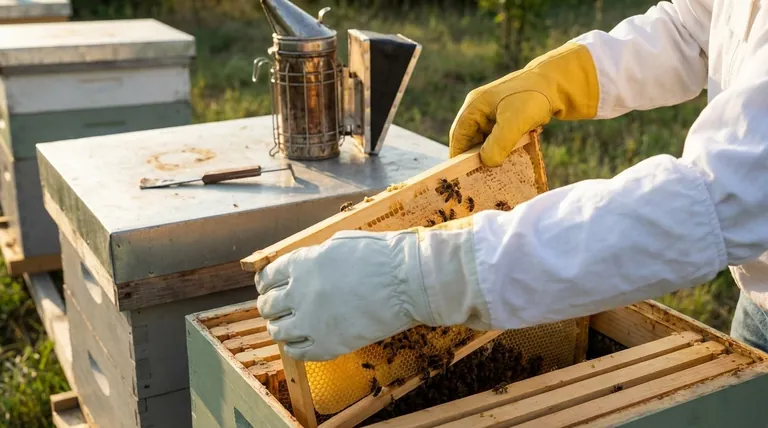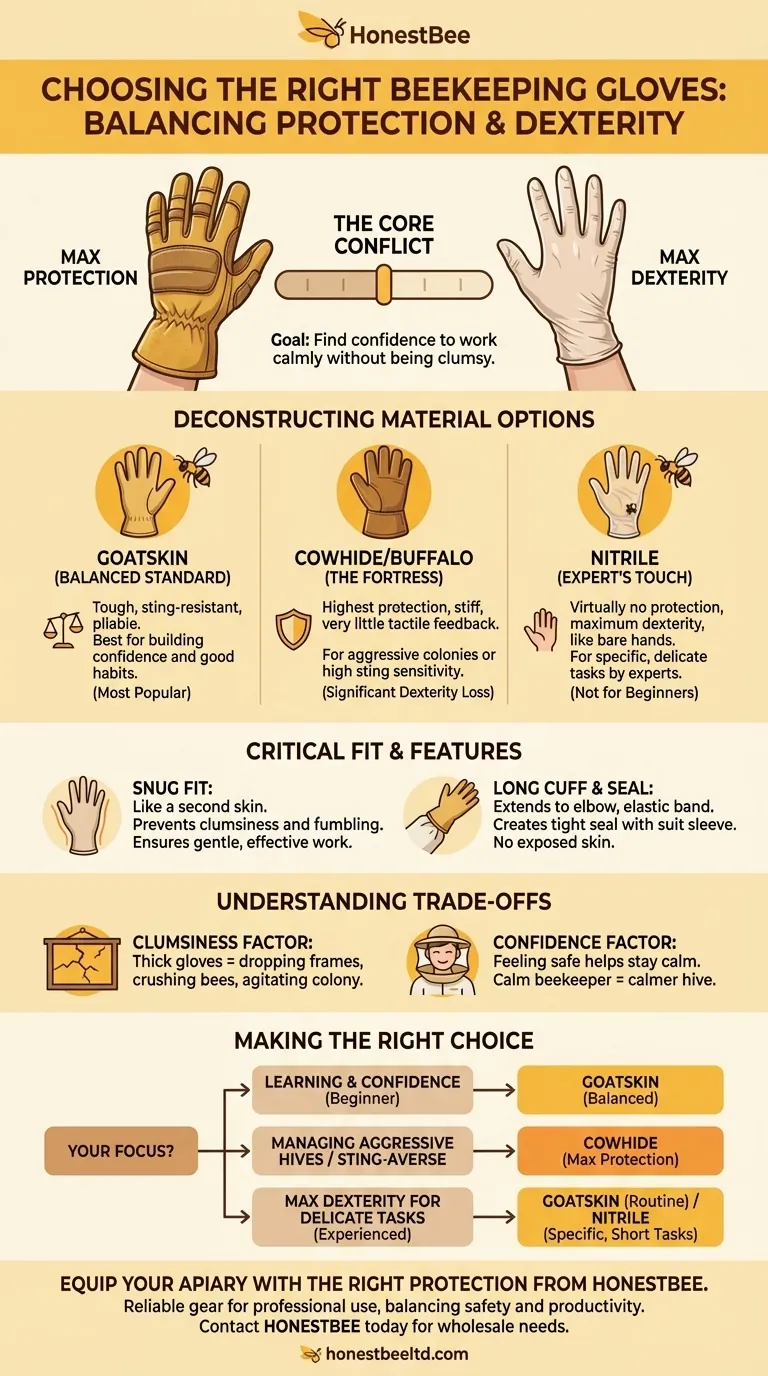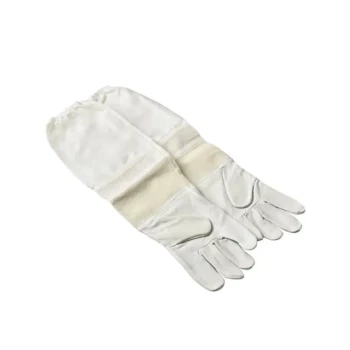When choosing beekeeping gloves, the three most critical factors to evaluate are the material, the fit, and the length of the cuff. These elements work together to determine your level of protection from stings and your dexterity—your ability to handle bees and equipment gently. The ideal choice is not simply the thickest glove, but the one that best balances these two competing needs for your specific skill level and hive temperament.
The central challenge in selecting beekeeping gloves is resolving the conflict between protection and dexterity. Your goal is to find a glove that gives you enough confidence to work calmly while providing enough feel to avoid being clumsy and agitating the colony.

The Core Conflict: Protection vs. Dexterity
Your hands are your primary tool in beekeeping. How you protect them directly impacts how you interact with the hive. Understanding the inherent tension between safety and function is the first step to making a wise choice.
Why Maximum Protection Isn't Always Best
Thick, clumsy gloves can make you feel invulnerable, but they significantly reduce your sense of touch.
This lack of dexterity can cause you to accidentally crush bees or drop a frame. Such actions release alarm pheromones, agitate the colony, and ultimately increase the likelihood of stings for you and unnecessary stress for the bees.
Why Dexterity Is Crucial for Good Beekeeping
Effective beekeeping requires gentle, deliberate movements. You need to be able to lift frames without rolling bees, use your hive tool with precision, and perform delicate tasks like marking a queen.
Gloves that allow for good dexterity enable you to be a calmer, more competent beekeeper, leading to a calmer hive and a more productive inspection.
Deconstructing Your Glove Options by Material
The material of your glove is the single biggest determinant of its balance between protection and dexterity.
Goatskin: The Balanced Standard
Goatskin is arguably the most popular material for a reason. It is tough and highly sting-resistant yet remains pliable and relatively thin.
These gloves offer an excellent middle ground, providing the confidence-inspiring protection a new beekeeper needs while allowing for the dexterity required to develop good habits.
Cowhide or Buffalo Leather: The Fortress
Thicker leathers like cowhide offer the highest level of protection. They are stiff and provide very little tactile feedback.
These are a viable choice for beekeepers handling particularly aggressive colonies or for those who are extremely sensitive to stings. However, you must be mindful of the significant loss in dexterity.
Nitrile Gloves: The Expert's Touch
Some highly experienced beekeepers use disposable nitrile exam gloves. These offer virtually no sting protection but provide maximum dexterity, almost like working barehanded.
This is an expert-level choice, best reserved for very specific, delicate tasks with a known calm colony. It is not recommended for beginners or routine inspections.
Critical Fit and Feature Considerations
Beyond material, the physical design of the glove ensures it functions as an integrated part of your protective suit.
The Importance of a Snug Fit
Your gloves should fit snugly, like a second skin, without being tight or restrictive. Excess material in the fingertips or palm will bunch up, making you clumsy.
A proper fit is a safety feature. It prevents you from fumbling with equipment and ensures you can work gently and effectively.
Cuff Length and Sealing
Beekeeping gloves must have long cuffs that extend well up your forearm, often to the elbow. This ensures there is no exposed skin between your glove and your suit sleeve.
The cuff should end in an elastic band to create a tight seal around your arm. For maximum security, the sleeve of your bee suit or jacket should be pulled down over the glove's cuff.
Understanding the Trade-offs
Choosing a glove is an exercise in managing compromises. Being aware of them helps you align your gear with your goals.
The Clumsiness Factor
Remember that a glove that makes you clumsy is a liability. Dropping a frame full of bees and brood is a catastrophic event that can be caused by gloves that are too thick and ill-fitting.
The Confidence Factor
For a new beekeeper, the psychological benefit of feeling safe cannot be overstated. Good protection helps you stay calm, and a calm beekeeper is a better beekeeper. Your initial priority should be building confidence.
Breathability and Comfort
Leather gloves can become hot and sweaty during long inspections on warm days. While not a primary functional concern, comfort affects your ability to focus.
Making the Right Choice for Your Goal
Select your gloves based on an honest assessment of your experience level and the temperament of your bees.
- If your primary focus is learning and building confidence as a new beekeeper: Choose a pair of high-quality goatskin gloves for the best all-around balance of protection and dexterity.
- If your primary focus is managing aggressive hives or you are highly sting-averse: Consider thicker cowhide leather for maximum protection, but practice your movements to compensate for the lack of feel.
- If your primary focus is maximum dexterity for delicate tasks (and you are experienced): Use your standard goatskin gloves for routine work and consider nitrile gloves only for specific, short-duration tasks with a calm hive.
The right gloves empower you to be a calm, confident, and gentle partner to your bees.
Summary Table:
| Factor | Importance | Key Options |
|---|---|---|
| Material | Determines protection vs. dexterity balance. | Goatskin (balanced), Cowhide (max protection), Nitrile (max dexterity) |
| Fit | Ensures safety and prevents clumsiness. | Snug, like a second skin, without restriction. |
| Cuff Length | Protects forearm and seals with suit. | Long cuff (to elbow) with an elastic band. |
Equip your apiary with the right protection from HONESTBEE.
Choosing the correct gloves is crucial for the safety and efficiency of your beekeeping operations. For commercial apiaries and distributors, having reliable, durable gear directly impacts productivity and colony health.
HONESTBEE supplies high-quality beekeeping gloves and a full range of equipment designed for professional use. We help you maintain a calm, productive hive through superior gear that balances protection and dexterity.
Ready to enhance your beekeeping practice? Contact HONESTBEE today to discuss your wholesale needs and find the perfect equipment for your business.
Visual Guide

Related Products
- Beekeeping Gloves Goatskin Leather with Long Cotton Sleeve for Beekeepers
- Goatskin Leather Beekeeper Gloves with Vent Long Sleeve for Beekeeping Honey Bee Sting Proof Protection
- Mesh Ventilated 3 Layer Goatskin Beekeepers Gloves for Beekeeping
- Goat Skin Leather Bee Sting Proof Beekeeping Gloves with Canvas Sleeve
- Professional Galvanized Hive Strap with Secure Locking Buckle for Beekeeping
People Also Ask
- What are the features of ventilated bee gloves? Stay Cool & Dexterous in Warm Weather
- Why are protective gloves important in beekeeping? Boost Confidence & Safety in Your Apiary
- What should beekeepers consider regarding the fit of beekeeping gloves? Achieve Safety and Dexterity
- What is the safest way to handle frames in beekeeping? Master Gentle Handling for a Calm Hive
- What are the arguments for and against using gloves in beekeeping? Balancing Protection and Dexterity



















